12 most popular FREE email providers
Looking for the best free email provider available nowadays? Find here an overview of the free top-rated email providers that you can trust!
Since Ray Tomlinson sent the first one in 1971, email has grown to define almost every aspect of our lives. The modern world revolves around email, with over 300 billion sent every day.
You probably have an email already – multiple, in fact. That said, it’s probably not meeting your needs. Otherwise, you wouldn’t be here searching for alternatives!
That said, we’re here to help. Below, you’ll find a comprehensive overview of the best free email providers in 2022. You’ll know which email suits your needs best by the end of this article.
An overview of the best email providers in 2022:
Without further ado, our list of the best email providers this year:
1. Gmail
Since 2004, Gmail has rapidly become the most popular email provider globally. Over 1.8 billion users enjoy its simplicity, security, and integration with the broader Google ecosystem. I recommend and use a Gmail account and Google Workspace for my personal and business needs. Therefore it is #1 on my list!
Key features:
- Plentiful storage: 15 GB of free storage space
- Confidential mode: Set expiration dates on your most private emails that recipients can only with by two-factor authentication. Also, recipients cannot forward, copy, print, or download
- Snooze: Do you ever open an email and then forget it? Snooze lets you schedule emails to reappear at a later time
- Extended attachment size: Direct integration with Google Drive allows Gmail users to send huge attachments. When attaching a file that surpasses the default 25MB limit, it will upload to Google Drive and attach a link
- Smart reply: With Gmail’s smart reply feature, your responses are autocompleted, saving writing time
- Google Ecosystem: Gmail integrates within the broader Google software suite. This means direction integration with Calendar, Tasks, Keep, and more
- Security: Gmail gives you great options when it comes to email security. Learn all about Gmail encryption and Gmail confidential mode with our detailed guides.
Drawbacks:
- Shared storage: The Gmail email provider shares storage space with other Google services

2. Outlook
Outlook started as Hotmail back in 1996. Since then, it’s grown to be the second most popular free email provider worldwide.
While Outlook is an excellent email service, that’s not all it is. Instead, it’s a comprehensive productivity suite featuring a calendar, a contact book, and a to-do list.
Key features:
- Focused Inbox: Outlook analyzes incoming emails and ranks them according to their importance using machine learning. The Focused tab displays important email messages while the Other tab hides the less essential ones
- Calendar: Organize appointments, meetings, or events directly from Outlook
- People: Easily store and access your contacts in Outlook
- Accessibility: Support for assistive devices, voice navigation, and more make Outlook an excellent choice for the impaired
- Quick Parts: Using Quick Parts, users can save and paste blocks of text at their convenience
- Security: Outlook and Office 365 feature a bunch of options for securing your Emails. Learn all about Outlook encryption and Outlook 365 email security with our detailed guides.
Drawbacks:
- The user interface is slightly cramped
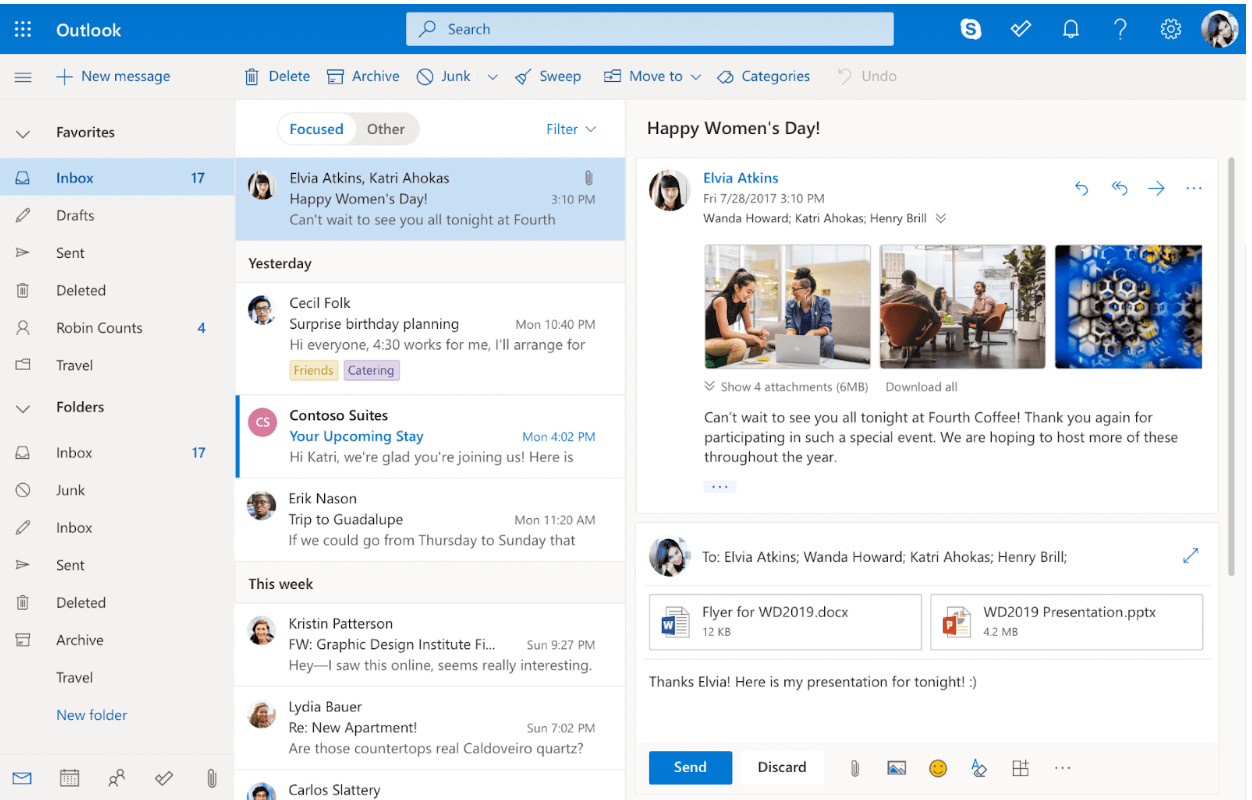
3. AOL
If you were an early adopter of the internet, AOL was probably your first email provider. But while the world may have moved past AOL, it never stopped providing a quality service.
Although it’s not the fanciest email service, it gets the job done. Users stick to AOL for its privacy and ease of use.
Key features:
- Unlimited storage: AOL is one of the only free email services to provide its users with unlimited storage
- Mass-deletion: AOL makes it easy to delete emails en masse. Other services struggle with this, forcing users to discard emails one after another
- Reading pane mode: Read emails without leaving your inbox
- Pop and IMAP support: Download emails directly onto your machine
Drawbacks:
- Limited attachment size: Unlike Gmail and Outlook, AOL doesn’t have an external drive to upload large files. As a result, you’re stuck with a modest attachment size
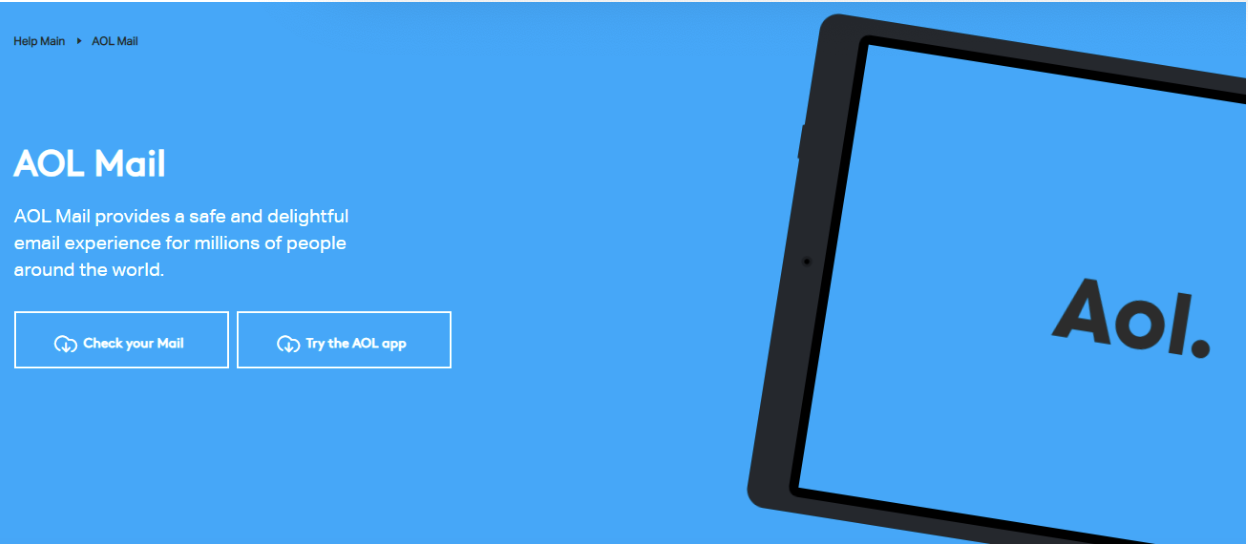
4. Proton Mail
ProtonMail is a highly secure email hosting provider born from the minds of CERN. It seeks to stand out from the competition by committing to a higher standard of user privacy.
Key features:
- Client-side encryption: Client-side encryption protects emails from being compromised by anyone, be they hackers or intrusive corporations
- Open-source: Any skeptics of Proton’s commitment to privacy can examine their source code for themselves
- Self-destruct: If you don’t want an email to exist forever, you can set it to delete after a period of time automatically
- Proton ecosystem integration: Proton Mail smoothly integrates into the broader Proton ecosystem. This ecosystem includes a calendar, file drive, and VPN.
Drawbacks:
- Limited storage: Proton gives free users a mere 500MB of space. This can seem relatively small compared to other services
- Subject line exposure: Proton Mail does not encrypt subject lines. Critics deride this privacy gap and cite Tutanota as an alternative that does encrypt them.
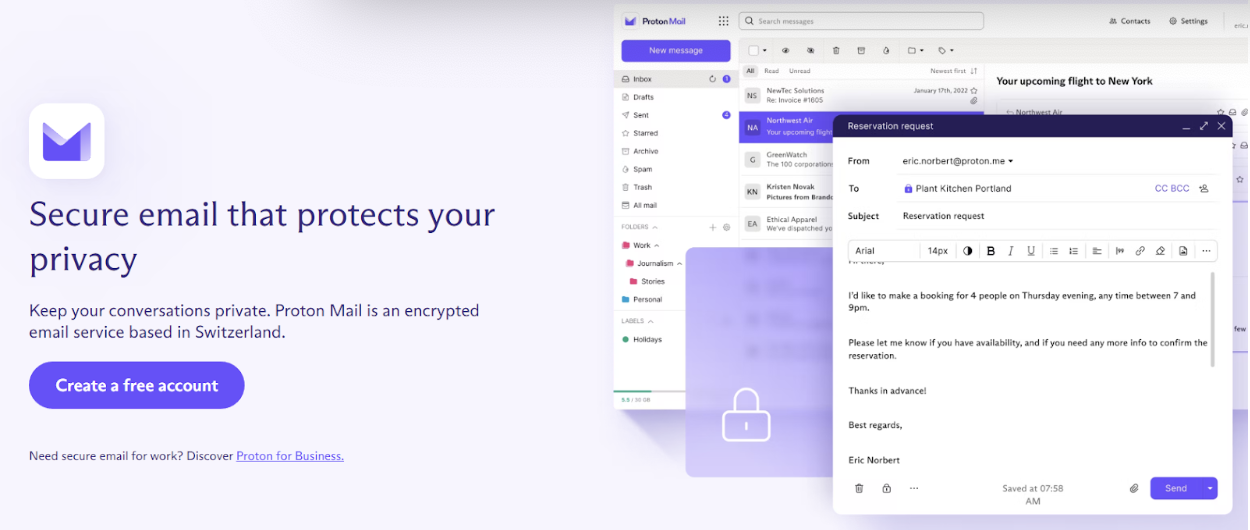
5. Zoho Mail
Zoho Mail is a free, secure email provider targeted toward professionals. It’s renowned for its high privacy standards, extensive customization, and broad functionality.
Key features:
- Productivity tools: Zoho offers extensive workflow functionality from directly within its inbox. Create tasks, events, and notes contextually from a given email
- Conversation streams: Ditch long email chains and replace them with instant messaging. You’ll have the ability to open a chat room with anyone present in an email chain. Even better, you don’t have to leave the email to use it
- Streamlined migration: Zoho makes it easy to transfer all your data from a previous email provider
Drawbacks:
- It needs a lot of customization before you can use it
- Customer support is limited
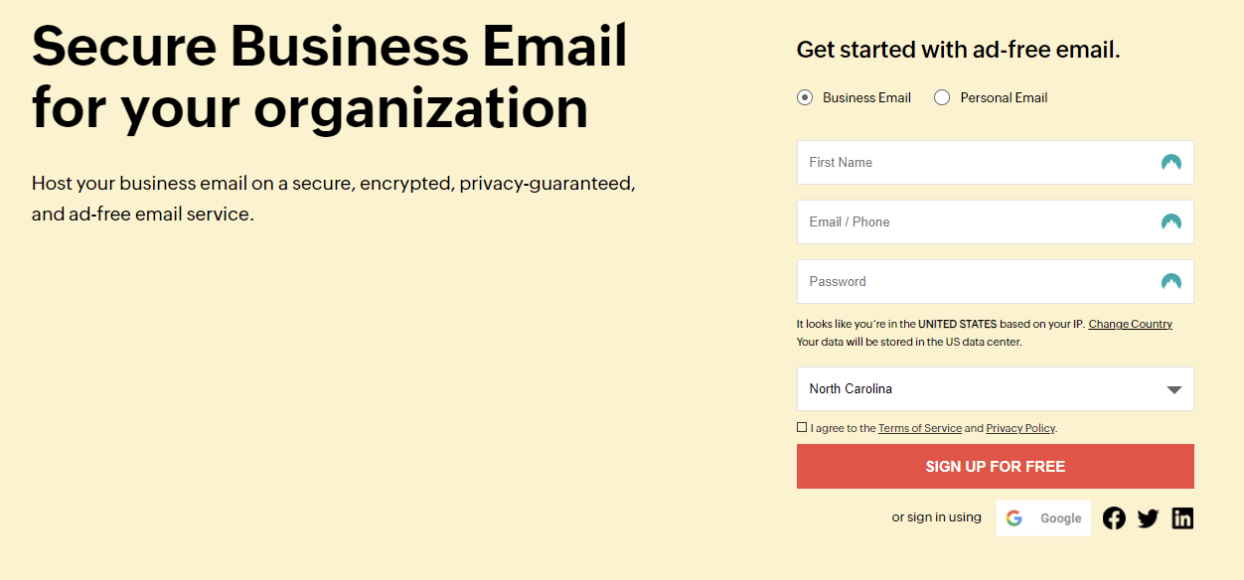
6. GMX
GMX (AKA Global Mail eXchange) is a free email provider based in Germany. It’s renowned for its extensive data allowances, such as 50MB attachment limits and unlimited storage.
Keep in mind that there are two versions of GMX:
- Global Mail eXchange (International)
- Global Message eXchange (German only)
The German version is slightly different from its global counterpart. For example, only the German version supports two-factor authentication.
Key features:
- Limitless storage space: Like AOL, GMX provides its users with unlimited storage
- Massive attachment limit: GMX allows users to attach files up to 50MB. This limit is noticeably larger than its competitors.
- GDPR-compliant: GMX is based in Germany, giving users get the benefits of European privacy protection
Drawbacks:
- Two-factor authentication is not available in GMX’s international version
- Its free service doesn’t support POP and IMAP
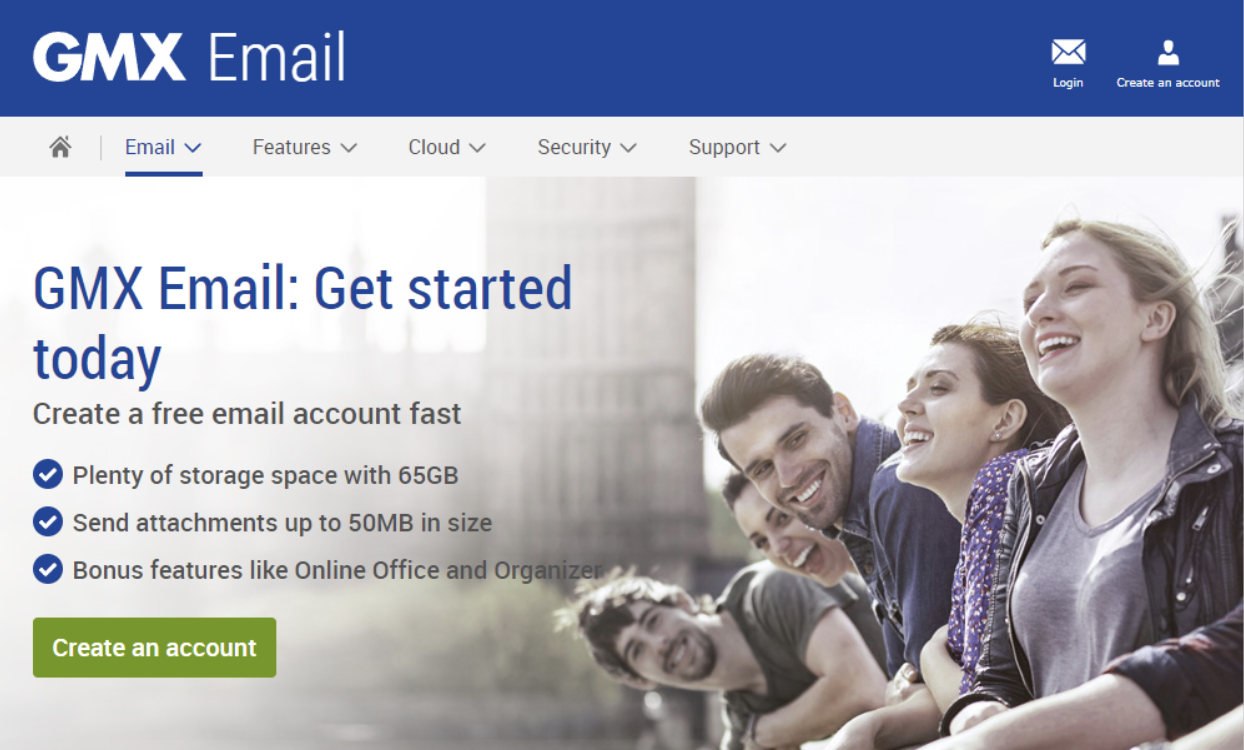
7. iCloud Mail
iCloud Mail is Apple’s premier email service. If you’re a fan of Apple’s ecosystem, it’s a great option to consider.
Truth be told, it isn’t as comprehensive as other choices on our free email providers list. That said, it’ll likely have everything you need in a personal email service.
Key features:
- Apple-friendly: iCloud Mail seamlessly integrates with the Apple ecosystem
- Customer support: Unlike other free email providers, Apple offers customer support to iCloud users when needed
Drawbacks:
- Apple designed iCloud mail to be a personal mail solution and nothing else. This makes for a pretty barebones experience, lacking in features other top email providers supply
8. Yahoo Mail
The Yahoo Mail service was launched in 1997 and remains one of today’s top email providers, used by 26% of Americans. While it lagged behind its competition for a while, its made significant strides in recent times.
Far beyond an inbox, Yahoo Mail strives to be the ultimate consumer email service. As a result, you can manage deliveries, travel bookings, and documents all from one place.
It’s also perhaps the most extensively customizable mobile inbox. You can adjust themes, text rising, contrast and more to make your inbox truly yours.
Key features:
- All-in-one inbox: You can add almost any email to your Yahoo inbox – Gmail, Outlook, or AOL; you name it.
- Subscription management: Manage and unsubscribe from mailing lists at your convenience
- Generous free storage: Yahoo gives free users a staggering 1TB storage
- Personalization options: Yahoo offers users tons of customization options, especially on mobile devices
Drawbacks:
- Limited customer service

9. Mail2World
Mail2World aims to be a comprehensive email experience. You can view inboxes, contacts, calendar events, and drive files all in one place.
Key features:
- One inbox for everything: Fetch emails from Gmail, Yahoo, Outlook, and other IMAP clients.
- Unified folders: Organize all your emails into one smart folder
- Customizable push notifications: Customize notifications according to sender, importance, folder, and more

Drawbacks:
- A clunky interface can provide occasional frustration
- Their small team means fewer updates than different email providers
10. Tutanota
Tutanota is a secure email provider based in Germany. Tutanota fully encrypts emails end-to-end, which they store on servers powered by renewable energy. You’ll commonly see them compared with Proton Mail – its main competitor.
Additionally, Tutanota provides a fully-encrypted calendar that users can access from any device. Even calendar notifications receive full encryption for a comprehensive privacy experience.
Lastly, Tutanota users are entirely anonymous since free users don’t need to provide any personal information whatsoever. All this comes wrapped in full GDPR compliance to form the ultimate private email provider.
Key features:
- German data protection: German privacy laws coupled with GDPR compliance means complete privacy for Tutanota users
- Open source: Tutanota’s source code is fully accessible to anyone who wishes to see it
- Broad device support: Send secure emails from anywhere with Tutanota’s iOS, Android, Windows, and Linux apps
- SecureConnect: Embed fully encrypted contact forms into your website, powered by Tutanota
- No ads: tutanota’s email inbox is distraction-free with no ads to distract users
- Calendar: Keep your schedule away from prying eyes with a fully-encrypted calendar
- Contacts: Tutanota keeps your contacts safe and available whenever you need them
Drawbacks:
- UI is slightly clunky compared to its direct competitors
- Only offers email support to paid users, while Proton Mail (its main competitor) provides support for all
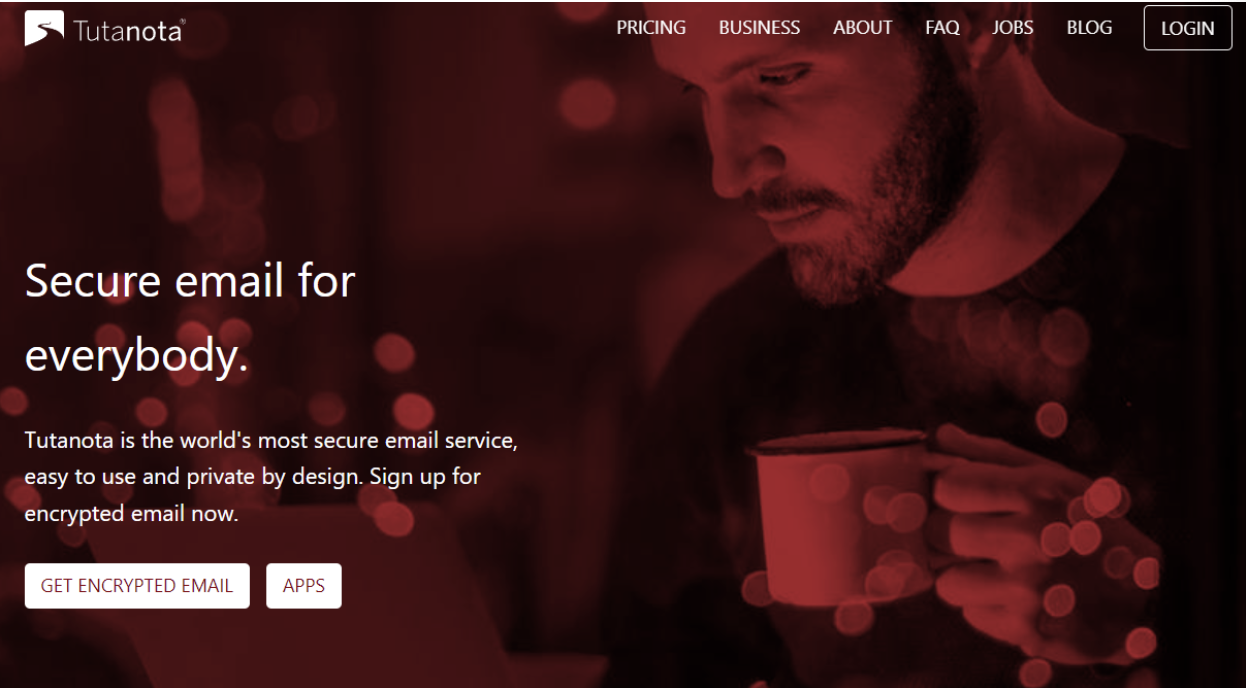
11. 10 Minute Mail
10-Minute Mail isn’t a typical free email account provider. Instead, its creators specifically designed it to allow users to avoid spam.
The gist is simple: whenever a service forces you to provide an email, you use this fake one instead. This way, you don’t have to worry about being tracked by them or being added to another mailing list.
After ten minutes, the email you receive will disappear forever (unless you extend the timer). Your emails will be gone, and the address will stop working.
Key features:
- Evade spam: 10 Minute Mail is a throwaway email you can give you anyone who wants your address. Just give them your 10-minute email address, and they’ll be unable to spam you, track you, or sell your email to third parties
- Server swap: 10 Minute Mail swaps its domain once a month, so website admins can’t block registrations from their email addresses
Drawbacks
- 10 Minute Mail emails disappear forever. If you set one of its emails as a recovery address, you’ll be unable to access it ever again

12. Juno.com
Juno is a free service that’s been faithfully serving clients since the 1990s. While it’s not the most advanced email service in the world, it meets most users’ needs.
Key features:
- Spam protection: Juno keeps you safe from malicious emails
- Mobile accessible: While Juno doesn’t have a mobile app, it is available via mobile browser
Drawbacks:
- Juno displays ads prominently within the inbox.
- Users can only log one into one session at a time
- Emails can arrive slowly
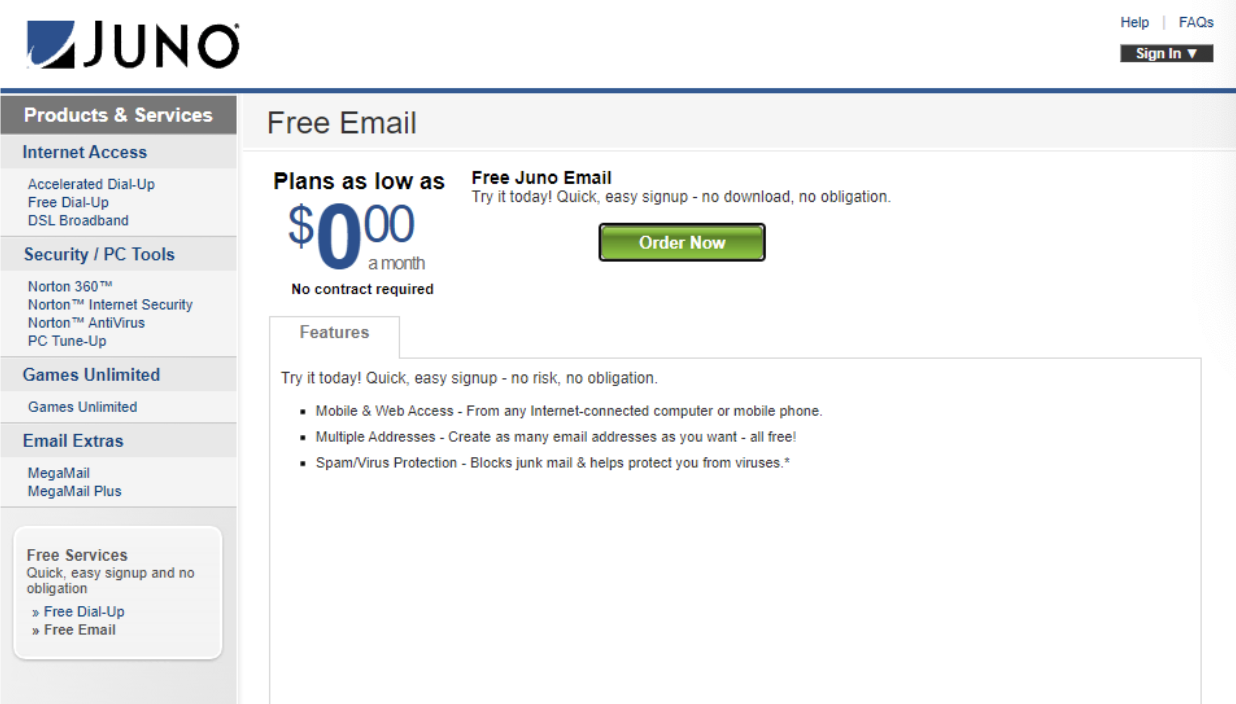
Tips for selecting a free email provider
Almost anything on the web requires an email address, whether it’s receiving a shipping invoice or signing up for Twitter. You’re going to use your email a lot, so you need to get it right.
Here are a few things to consider when choosing a free email provider:
1. Privacy
They say, “if something’s free, you’re the product.” After all, those companies aren’t running a charity.
Many email providers will likely sell your information to third parties unless stated otherwise. Of course, they will disclose this openly as legally required, but that doesn’t make it less unsettling.
Selling information is one way they make money off of their “free” service. If privacy matters to you, consider choosing a privacy-focused email hosting provider like Proton Mail or Tutanota.
2. Storage capacity
When setting up your email for the first time, storage will probably be the furthest thing from your mind. The problem is that emails can stack up quickly, resulting in your storage space decreasing equally as fast.
If you don’t want to stress over storage space, consider providing a generous storage allowance.
3. Features
Most email services don’t just provide email anymore. They also offer calendars, contact books, and to-do lists. Some take this even further with extensive productivity tools.
The point is that not all email providers are equal; some provide much richer experiences than others. With that in mind, consider the feature set of any email provider carefully. While you won’t need all of them, you’ll probably find some pretty helpful.
How to keep multiple email accounts organized
The odds are you’ll end up with multiple email addresses. This can happen for several reasons: work and personal addresses, throwaway emails, etc.
Whatever the case may be, it’s not a question of if; it’s a question of when. And when those accounts start to become overwhelming, all-in-one email clients are the best way of organizing them.
A couple of the entries on our free email providers list have all-in-one functionality (Yahoo, for example).
There are also desktop platforms for this purpose, like Mailbird or Thunderbird.
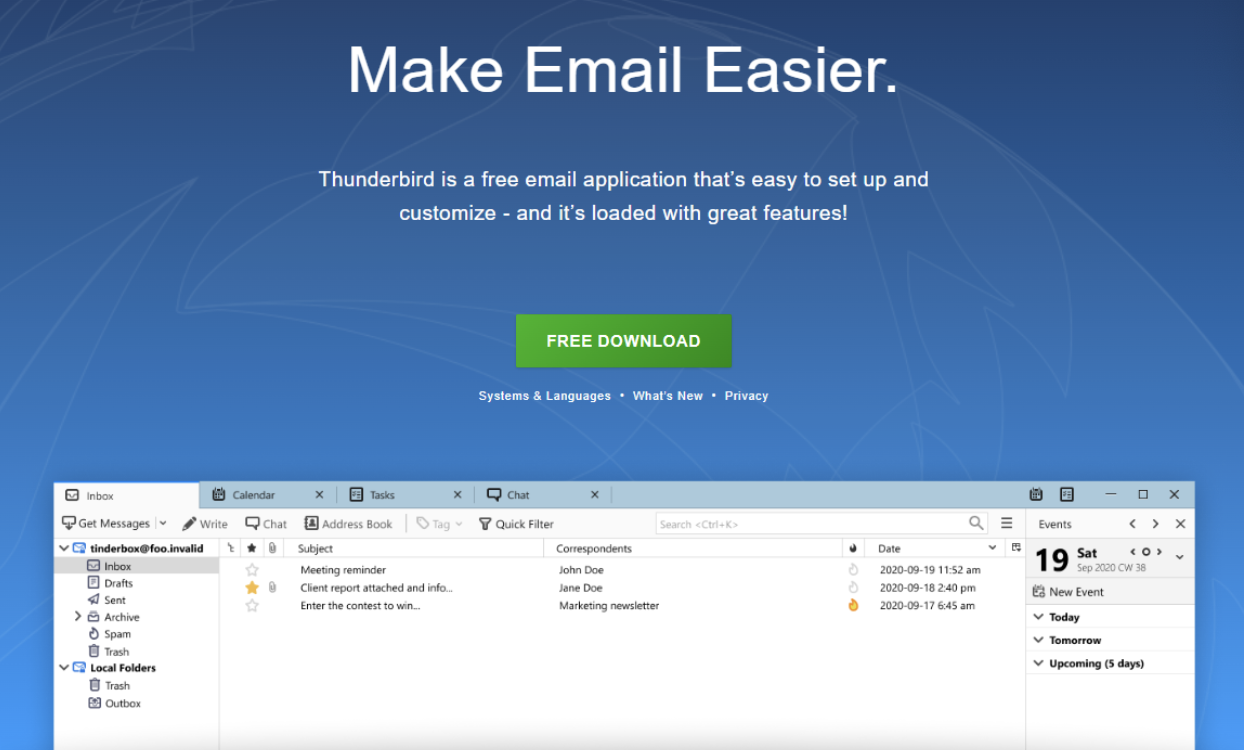
Final thoughts
Email isn’t going anywhere. In fact, it’s only growing; there are four billion daily email users and counting.
Each of those emailers had to choose an email provider. While most of them may have picked Gmail, that isn’t necessarily the best choice for you. Ultimately, the best email provider is the one that meets your unique needs.
Above, we ranked the best free email account providers according to their merit. However, our #1 isn’t necessarily your #1; it’ll be up to you to decide which email provider satisfies your needs best.

